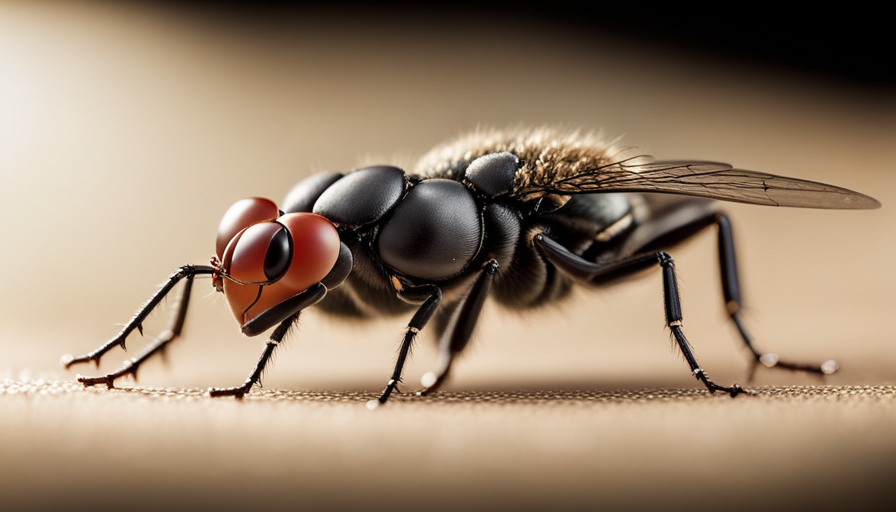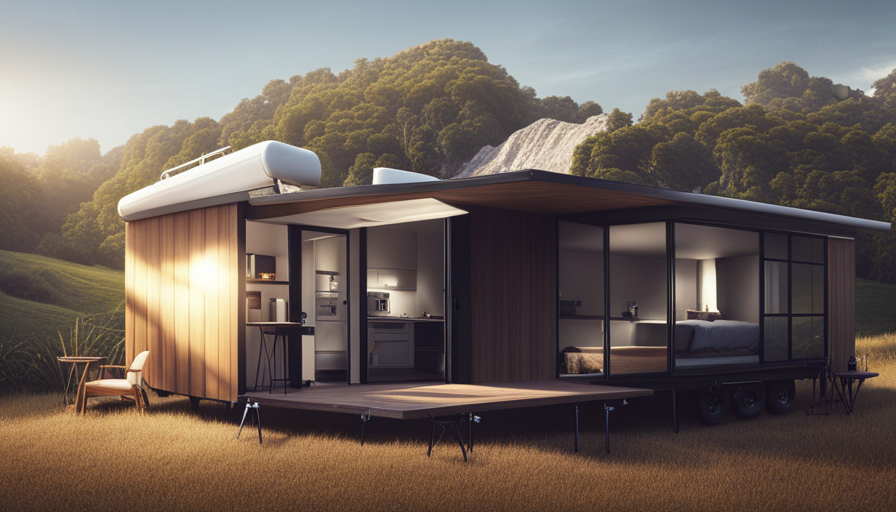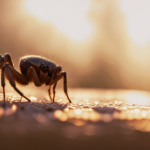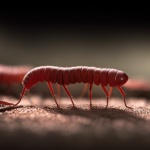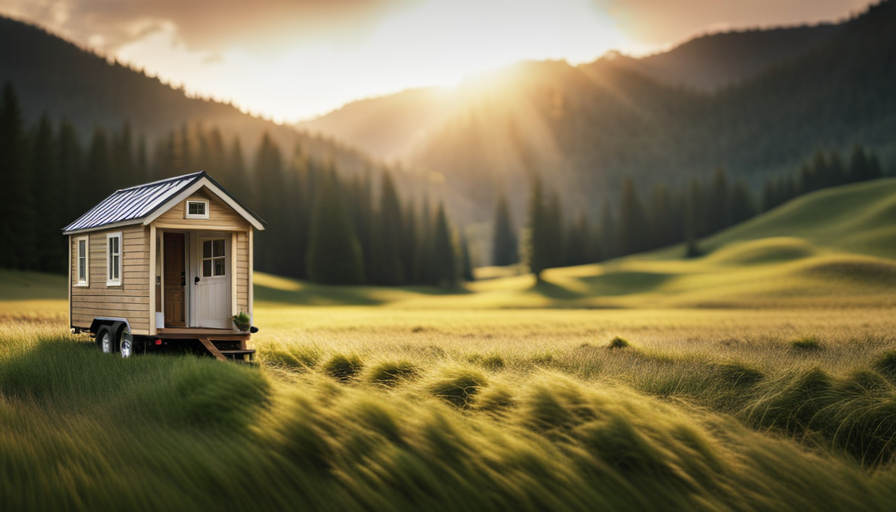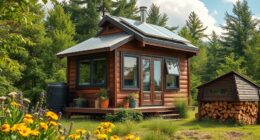Imagine yourself on a warm summer day, relaxing on your porch and enjoying the gentle breeze. But this peaceful moment is interrupted when a tiny house fly flies past your ear. You try to swat it away, wanting to get rid of this irritating pest, but have you ever thought about the lifespan of these tiny creatures?
In this article, we will delve into the fascinating world of house flies and explore the intricate details of their lifespan. From the moment they emerge from their eggs to the final stages of their adult lives, we will uncover the secrets of their existence. We will also discover the average lifespan of house flies, as well as any exceptional cases that defy the norm.
By understanding the lifecycle of these tiny insects and implementing effective control measures, we can better manage their populations and maintain a more comfortable living environment. So, let’s embark on this scientific journey and uncover the mysteries of how long those tiny house flies truly live.
Key Takeaways
- Female house flies can lay up to 500 eggs during their lifetime.
- The lifespan of a house fly can range from a few weeks to a couple of months, influenced by factors like temperature and reproduction rate.
- Warmer temperatures accelerate the development of house flies, while colder temperatures extend their lifespan.
- Understanding the factors that contribute to house fly longevity is important for population control and minimizing their presence.
The Life Cycle of a House Fly
The life cycle of a house fly is a fascinating process that includes four distinct stages, each with its own unique characteristics. Understanding the life cycle of a house fly is important for controlling their populations and preventing infestations.
House flies, scientifically known as Musca domestica, are known for their rapid reproduction and ability to adapt to various environments. They have a wide range of behavior and can be found in both indoor and outdoor habitats. They are attracted to decaying organic matter, such as garbage, feces, and rotting food. House flies are also known to inhabit areas near livestock and poultry facilities, as they are attracted to the manure produced by these animals.
The first stage of the house fly life cycle is the egg stage, which lasts for around 24 hours. Female house flies can lay up to 500 eggs during their lifetime. These eggs are usually laid in batches and can be found in moist areas, such as rotting organic matter or animal feces.
In the subsequent section about the egg stage, we will explore the process from birth to hatching and how it contributes to the overall life cycle of a house fly.
The Egg Stage: From Birth to Hatching
From birth to hatching, it’s a mesmerizing journey for these little creatures. The life cycle of a house fly starts with the egg stage, which is a crucial step in their development.
The birth process begins when a female house fly deposits her eggs on a suitable substrate, such as decaying organic matter. Each female fly can lay up to 500 eggs in her lifetime. These small, white eggs measure about 1.2 millimeters in length and resemble grains of rice.
The hatching duration varies depending on environmental conditions, but it typically takes around 8 to 24 hours for the eggs to hatch. During this time, the eggs undergo embryonic development, where the larvae grow inside the protective shell. As the hatching process nears completion, the eggs darken in color, indicating the imminent emergence of the larvae.
As the eggs hatch, the next stage of the house fly’s life cycle begins: the larval stage. During this phase, the larvae actively feed and grow, setting the stage for their transformation into pupae. The larval stage is a crucial period for the house fly’s development, as it provides the necessary nutrients for their growth and prepares them for the next stage of their lifecycle.
Moving on to the larval stage: feeding and growing, the house fly larvae undergo remarkable changes as they continue their journey towards adulthood.
The Larval Stage: Feeding and Growing
During this stage, the wriggling larvae voraciously devour decaying matter, fueling their rapid growth and transformation. The feeding habits of these tiny house fly larvae are an essential part of their life cycle stages. As they hatch from eggs, the larvae immediately start searching for decaying organic material to feed on. They have a strong sense of smell, which guides them towards their preferred food sources.
Once they find suitable matter, they use their mouthparts to scrape and ingest it. These larvae are not picky eaters and will consume a wide range of decaying substances, including food scraps, animal waste, and rotting vegetation. They play a crucial role in breaking down and recycling organic matter in the environment. Their feeding activity not only provides them with the necessary nutrients for growth but also helps to decompose organic material, contributing to the overall ecosystem.
As the larvae feed, they undergo multiple molts, shedding their exoskeletons to accommodate their increasing size. This process allows them to grow rapidly and progress through the larval stage. After a period of intense feeding and growth, the larvae reach a stage where they are ready to enter the next phase of their life cycle: the pupal stage.
During this stage, they undergo a remarkable transformation and development, preparing to emerge as adult house flies. Transitioning from the larval stage to the pupal stage, the tiny house fly larvae go through an incredible metamorphosis.
The Pupal Stage: Transformation and Development
Witness the incredible transformation and development as you enter the pupal stage, where these wriggling larvae undergo a remarkable metamorphosis. During this stage, the tiny house fly larvae, known as maggots, transform into pupae.
This transformation process involves a series of intricate physical changes that prepare the fly for its adult stage.
-
Exoskeleton Hardening: As the larvae enter the pupal stage, their soft exoskeleton undergoes a process called sclerotization. This hardening of the exoskeleton provides protection and support for the developing fly.
-
Internal Reorganization: Within the pupa, the larval tissues and organs undergo extensive reorganization. The digestive system, which was previously adapted for feeding on decaying matter, degenerates and is replaced by the adult digestive system.
-
Wing and Leg Development: One of the most significant physical changes during the pupal stage is the development of wings and legs. These appendages, crucial for the adult fly’s ability to fly and move, form and lengthen within the pupal case.
As the pupal stage concludes, the adult house fly emerges, ready to begin its reproductive journey. The incredible transformation and development witnessed in the pupal stage sets the stage for the adult stage’s vital processes, including reproduction and lifespan.
The Adult Stage: Reproduction and Lifespan
Get ready to witness the amazing reproductive journey and lifespan of adult house flies! The adult stage of a house fly’s life is focused on reproduction and plays a crucial role in the continuation of their species.
After emerging from the pupal stage, adult flies are ready to mate and reproduce. The duration of the reproductive phase varies, but on average, it lasts for about two weeks. During this time, female house flies can lay up to 500 eggs, which are deposited in favorable breeding sites such as decaying organic matter.
As the adult house fly ages, it goes through a natural aging process. Initially, the flies are vibrant and active, but as time passes, signs of aging become apparent. These signs include a decrease in flight activity, loss of appetite, and a gradual decline in overall health.
The lifespan of a house fly can range from a few weeks to a couple of months, depending on various factors such as environmental conditions and availability of food sources.
Understanding the reproductive duration and aging process of adult house flies is essential in comprehending their overall lifespan. Factors affecting the lifespan of house flies will be explored in the subsequent section, shedding light on the intricate interplay between the environment and the longevity of these tiny creatures.
Factors Affecting the Lifespan of House Flies
The lifespan of adult house flies can be influenced by a variety of factors, including environmental conditions and the availability of food sources. One major factor that affects the lifespan of house flies is temperature. House flies thrive in warm environments, with their ideal temperature range being between 77°F and 86°F (25°C and 30°C). In colder temperatures, their metabolic rate decreases, causing them to slow down and potentially die. On the other hand, extremely high temperatures can also be detrimental to their survival as they are unable to regulate their body temperature effectively.
To better understand the impact of temperature on the lifespan of house flies, consider the table below:
| Temperature (°F) | Lifespan (days) |
|---|---|
| 77°F | 28 |
| 86°F | 14 |
| 95°F | 8 |
| 104°F | 3 |
As shown in the table, higher temperatures significantly reduce the lifespan of house flies. It is important to note that these values may vary depending on other factors such as humidity and availability of food sources.
Considering the impact of temperature on the lifespan of house flies, it becomes evident that environmental conditions play a crucial role in their survival. In the next section, we will explore how other environmental factors can affect the lifespan of these tiny flies.
Environmental conditions
Immerse yourself in the world of house flies and discover how their existence is shaped by the ever-changing tapestry of environmental conditions. House flies, being ectothermic organisms, are highly influenced by the environmental conditions surrounding them. The effects of climate change have a significant impact on their lifespan and overall population dynamics.
-
Extreme temperatures: Fluctuations in temperature can have profound effects on the life cycle and longevity of house flies. High temperatures can accelerate their life cycle, resulting in shorter lifespans, while cold temperatures can delay their development and longevity.
-
Humidity levels: House flies thrive in environments with high humidity levels. Adequate moisture is essential for their survival, as it promotes the growth of the microorganisms they feed on. However, excessive humidity can also facilitate the spread of diseases carried by house flies, posing a risk to human health.
-
Pollution levels: The presence of pollutants in the environment can affect the lifespan of house flies. Toxic substances, such as pesticides and pollutants from industrial activities, can directly impact their health and decrease their lifespan.
These environmental conditions, influenced by climate change and human activities, not only affect the lifespan of house flies but also have implications for human health. As we delve into the next section about the availability of food and water, we will further explore the intricate relationship between house flies and their environment.
Availability of food and water
With the ever-changing environmental conditions, it’s fascinating to explore how the availability of food and water shapes the survival and behavior of house flies. These small insects have a relatively short lifespan, typically living for about 15 to 30 days. During this time, their access to food and water plays a crucial role in their overall health and ability to reproduce.
House flies are known for their ability to feed on a wide variety of organic material, including decaying matter, garbage, and even feces. Their mouthparts are specifically adapted for sponging up liquid substances, allowing them to extract nutrients from these food sources. Therefore, the availability of food is essential for their survival.
Flies are attracted to areas with abundant food resources, such as kitchens, trash cans, and animal waste.
Similarly, water availability is essential for the house fly’s survival. These insects require water for their metabolic processes and to maintain proper hydration. They are often found near moist areas, such as drains, wet soil, or even pet water bowls.
Understanding the influence of food and water availability on house flies is crucial in developing effective pest management strategies. By manipulating these factors, we can potentially control their population and minimize their impact on human health and hygiene.
Considering the significance of food and water availability, it is also important to examine the role of predators and diseases in shaping the population dynamics of house flies.
Predators and diseases
Imagine being a homeowner and discovering a web of hungry spiders lurking in dark corners, patiently waiting to pounce on any unsuspecting house fly that ventures too close. As a tiny house fly, I’m well aware of the constant threat that predators pose to my existence. The predator-prey dynamics in the world of house flies are crucial for understanding our population dynamics and the impact we have on human health.
Here are four key points to consider:
-
Spiders: These eight-legged predators are one of the most significant threats to house flies. With their quick reflexes and venomous bites, they efficiently capture and consume us, helping control our population.
-
Birds: Many bird species, such as swallows and sparrows, rely on house flies as a food source. Their aerial acrobatics and sharp beaks make them formidable predators, reducing our numbers and limiting our spread.
-
Bacteria and Viruses: House flies can serve as vectors for various diseases, including Salmonella and E. coli. These pathogens can survive in our bodies and be transmitted to humans through contact or contaminated food, highlighting the potential impact on human health.
-
Other Insects: Predatory insects like dragonflies and mantises also pose a threat to house flies. Their stealthy hunting techniques and sharp mouthparts make them efficient predators, contributing to our natural regulation.
Understanding the complex predator-prey dynamics and their impact on human health is crucial in managing house fly populations. Transitioning into the subsequent section about the average lifespan of house flies, it’s important to explore how these factors influence our survival and reproduction.
Average Lifespan of House Flies
Predators and diseases play a significant role in influencing the lifespan of house flies. However, there are other factors that also impact their longevity. As a researcher, I find it fascinating to study the average lifespan of these tiny creatures.
House flies typically live for about 15 to 30 days, although this can vary depending on various factors. One of the key factors influencing their lifespan is temperature. Flies thrive in warm environments, and higher temperatures can accelerate their development and shorten their lifespan. Additionally, temperature also affects the rate of reproduction and the survival of the fly larvae.
When the temperature drops, house flies become less active, and their lifespan may extend beyond the usual 30 days. On the other hand, in warmer climates, flies may only live for a shorter period. It is crucial to understand the impact of temperature on the lifecycle of house flies as it helps us predict their population dynamics and implement effective pest control strategies.
Understanding the average lifespan of house flies provides us with valuable information about their reproductive potential, population growth, and overall ecological impact. However, it’s also interesting to explore the exceptional cases of longevity and the factors that contribute to these outliers.
Transitioning into the next section, let’s now delve into the longevity records and exceptions observed in the world of house flies.
Longevity Records and Exceptions
Surprisingly, even the tiniest of creatures like house flies have been known to defy the odds and achieve remarkable longevity, proving that age is just a number.
While the average lifespan of a house fly is only around 15-30 days, there have been some exceptional cases where these tiny insects have lived much longer.
Various factors contribute to the longevity of house flies, including environmental conditions, the availability of food sources, and genetic variations within the population.
Research has shown that house flies raised in controlled laboratory conditions tend to have shorter lifespans compared to those living in their natural habitats. This suggests that environmental factors play a significant role in determining the lifespan of house flies.
Additionally, genetic variations within the species can also influence their longevity. Certain genetic traits may make some flies more resilient and better equipped to survive adverse conditions, allowing them to live longer than their counterparts.
Understanding the factors that contribute to the longevity of house flies is crucial for effective fly population control. By targeting the environmental conditions that promote their survival and reproduction, we can effectively reduce their lifespan and mitigate their impact.
This knowledge can help us develop strategies and techniques to control house fly populations and minimize their presence in our surroundings.
Tips for Controlling House Fly Populations
After discussing the longevity records and exceptions of house flies, let’s now focus on some practical tips for controlling house fly populations and preventing fly infestations.
It is crucial to take proactive measures to reduce the presence of house flies in our homes and surrounding areas.
Firstly, maintaining a clean and hygienic environment is essential. Regularly dispose of garbage in sealed bags and ensure proper sanitation practices. Clean up spills and food residues promptly, as these serve as attractive food sources for flies. Additionally, regularly clean your trash cans and keep them tightly closed to prevent flies from accessing them.
Secondly, consider implementing physical barriers to prevent flies from entering your home. Install window screens and door sweeps to keep flies out while allowing fresh air to circulate. Seal any gaps or cracks in walls, windows, and doors to minimize entry points.
In conjunction with these measures, using fly repellents and traps can provide an extra layer of defense. There are various commercial fly repellents available, as well as DIY solutions such as vinegar or essential oil-based sprays. Fly traps can also be effective, especially those that use attractants or sticky surfaces.
By implementing these strategies, we can significantly reduce house fly populations and minimize the risk of fly infestations. Understanding the lifespan of house flies will further enhance our ability to control and manage these pests effectively.
Conclusion: Understanding the Lifespan of House Flies
To effectively manage and control fly populations, it’s important to understand the lifespan of these pesky insects. The lifespan of house flies can vary depending on various factors.
On average, a house fly can live for about 15 to 30 days. However, this lifespan can be influenced by environmental conditions, availability of food sources, and the presence of predators.
One of the key factors affecting the lifespan of house flies is temperature. Flies thrive in warm weather, and their lifespan can be shortened in cooler temperatures. Additionally, the availability of food plays a crucial role. Flies require a diet of organic matter, such as garbage or decaying food. If their food sources are limited, their lifespan may be shorter.
Managing fly populations is essential in controlling their lifespan. Proper sanitation practices can help eliminate potential breeding sites and reduce the availability of food for flies. Regularly cleaning and disposing of waste, as well as keeping food covered and sealed, can significantly impact fly populations.
Understanding the lifespan of house flies is crucial in effectively managing and controlling their populations. Factors such as temperature and food availability can influence their lifespan. By implementing proper sanitation practices and reducing their access to food, we can help manage fly populations and minimize their impact on our surroundings.
Frequently Asked Questions
Can house flies transmit diseases to humans?
Yes, house flies can transmit diseases to humans. Although their lifespan is short, around 15-30 days, they can cause significant harm. House flies go through a complete life cycle, starting as eggs and progressing to larvae and then pupae before reaching adulthood. During their lifecycle, house flies feed on a wide variety of organic matter, including rotting food and feces. This makes them potential carriers of diseases such as cholera, typhoid, and dysentery, as they can contaminate food and surfaces with pathogens.
How quickly do house fly populations reproduce?
House fly populations reproduce rapidly due to their short life cycle and high reproductive capacity. The house fly life cycle consists of four stages: egg, larva, pupa, and adult. Under optimal conditions, the entire life cycle can be completed in as little as 7-10 days.
Factors affecting the house fly reproduction rate include temperature, humidity, and availability of suitable breeding sites. These factors can greatly influence the speed at which house fly populations increase.
Are house flies more active during certain seasons?
House flies exhibit distinct seasonal patterns of activity, with their behavior influenced by climatic conditions. These insects tend to be more active during warmer seasons when temperatures are favorable for their growth and reproduction.
However, the impact of climate change on house fly populations is a concern. Rising temperatures and altered weather patterns may lead to longer and more intense breeding seasons, potentially causing an increase in house fly populations and associated issues.
What are the most effective methods for controlling house fly populations?
Biological control and chemical control are the most effective methods for controlling house fly populations. Biological control involves using natural enemies such as parasitoids and predators to reduce fly numbers. This method is environmentally friendly and sustainable.
Chemical control involves the use of insecticides to kill flies. It’s important to use insecticides that are specifically designed for house flies and follow label instructions for safe and effective application.
Both methods can be used in conjunction to achieve optimal control.
Can house flies survive in extreme temperatures?
House flies, those pesky insects, are surprisingly hardy when it comes to extreme temperatures. They have the remarkable ability to survive in both hot and cold conditions. In fact, they can withstand temperatures as low as 32°F (0°C) and as high as 120°F (49°C). This adaptability allows them to thrive in various environments, making them a persistent nuisance in both indoor and outdoor settings.
Conclusion
In conclusion, understanding the lifespan of house flies is crucial in controlling their populations. House flies go through four stages of life: egg, larva, pupa, and adult. The average lifespan of a house fly is around 15 to 30 days, but some can live up to 2 months.
While this may seem relatively short, house flies can reproduce quickly, leading to large populations. To combat this, it’s important to implement effective fly control measures. By doing so, we can visualize a home free from these pesky insects and ensure a clean and hygienic environment.
Hi, I’m Emma. I’m the Editor in Chief of Tiny House 43, a blog all about tiny houses. While tree houses are often associated with childhood, they can be the perfect adult retreat. They offer a cozy space to relax and unwind, surrounded by nature. And since they’re typically built on stilts or raised platforms, they offer stunning views that traditional homes simply can’t match. If you’re looking for a unique and romantic getaway, a tree house tiny house might just be the perfect option.
